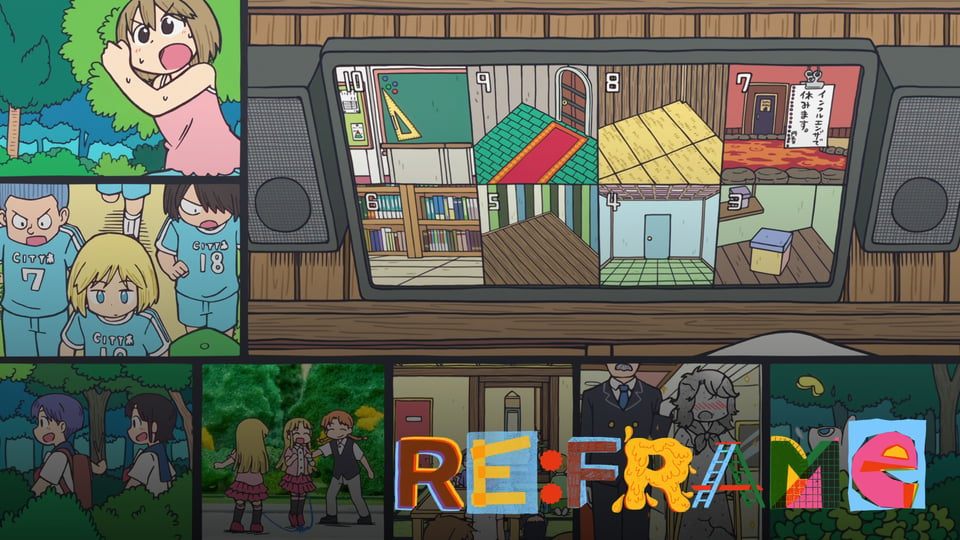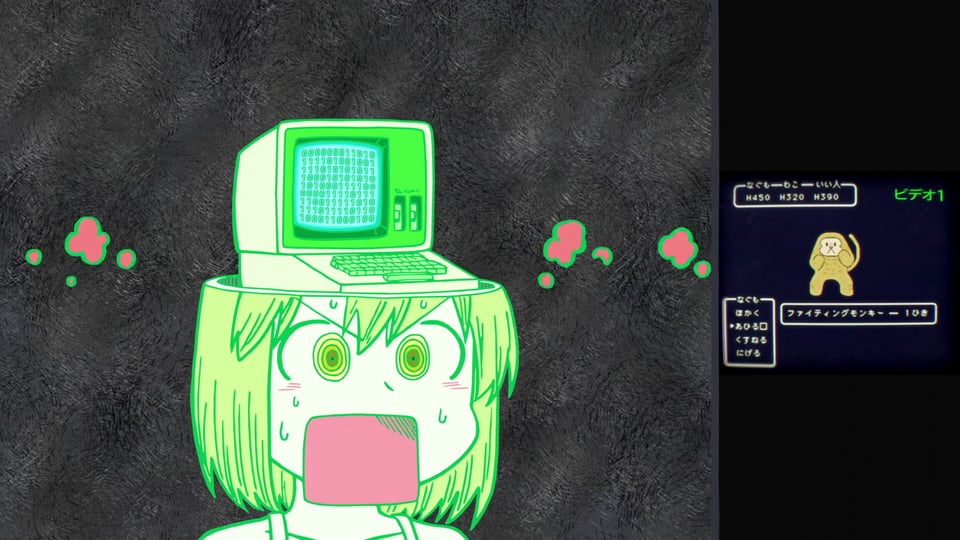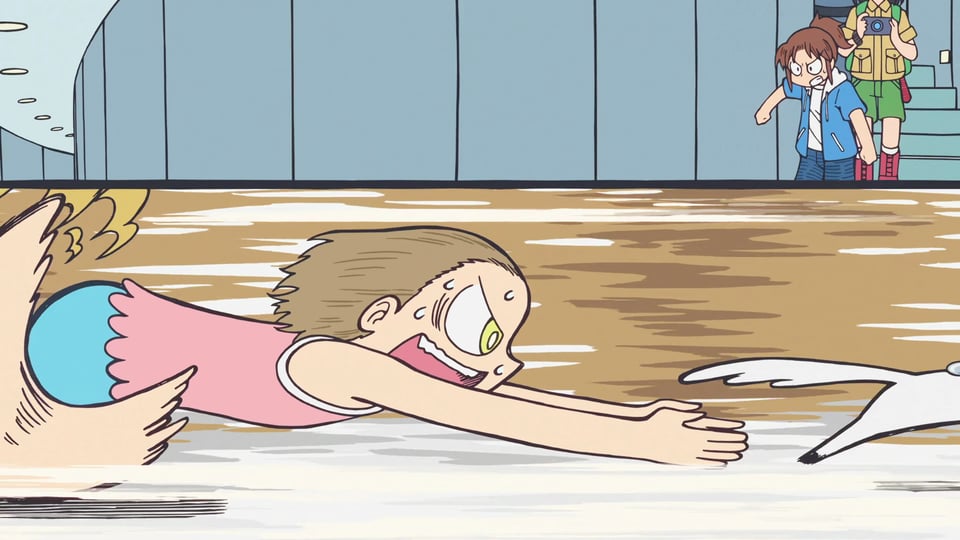CITY animates everything, everywhere, all at once
The fifth episode of this ambitious anime breaks the on-screen image into multiple moving parts.
by Kambole Campbell

Considering that this newsletter is called re:frame, there might not be an episode of animation more suited to that title than the fifth episode of CITY: The Animation – which builds to an astonishing sequence where the frame is split into multiple moving parts. The sheer amount of information on screen is breathtaking; a credit to the sharpness of the show's sight gags and bizarre jokes that you can look at any part of the (completely wild) layout and find something to make you laugh.
CITY (sadly, steaming on Prime Video internationally) is an adaptation of the manga by Keiichi Arawi, by the artists at Kyoto Animation. Over a decade ago, the same studio worked on Nichijou (directed by Tatsuya Ishihara), a manga from Arawi which looked at the everyday life of a group of high school girls through a surrealist comedy lens. That viewpoint quickly expanded outwards – the frivolities of teenagers contrasted with the equally silly fretting of their elders. Also, there was a robot. CITY mostly skews towards its adult populace, from struggling artists to college students clawing to make rent in any way they can.
Taichi Ishidate, a storyboard artist and episode director on Nichijou, heads up series direction. There's a familiar rhythm to its comedy, full of non-sequiturs, bizarre word play and incredibly silly acts of violence, but that feels like a natural result of it being a work by the same author (for example, pro wrestling moves still frequently appear as a sight gag: a teacher quizzes teenagers on Karl Gotch, a writer puts his editor in a sharpshooter submission hold, etc.).
That previous adaptation remained in people's hearts because of the inventive ways it sought to communicate Arawi's sense of humor, one realized with frequently astonishing production values. It's something which I and other fans of the series have appreciated as part of the joke, that an incredibly silly tangent is treated as room to experiment, with as much grandeur and artistic rigor as KyoAni's more introspective productions (as it should be – recent films like The Naked Gun reinforce that good comedy requires tight control of blocking and onscreen space as much as it does good written gags).

Although CITY doesn't quite have the density of gags nor the hit rate of The Naked Gun (for me, anyway), it's a testament to the artists that it feels more ambitious in its visual craft in telling these jokes than even Nichijou was. In production notes for "The Tower", director Taichi Ishidate talks about how development of the detail-rich background art was key to the look of the show – saying initially they leaned into a "pop art-inspired" visual style, before settling into a look where, "the backgrounds became virtually indistinguishable from the cel animation layers" (if you don't know what that means don't worry, Ishidate also explains that).
That holistic approach to the frame immediately sets CITY apart visually, but there's more to it. SakugaBlog's typically thorough writing on the first episodes underline not just the show's cartoony animation and Arawi's close collaboration with production, but also pinpoints "simultaneity" as what separates CITY even from its predecessor. Kevin Cirugeda (aka kViN) writes that the show is, "not about individuals but entire neighborhoods, the way that you can notice how all the ridiculous hijinks are happening at the same time and interacting with each other."
"The Tower" is this "simultaneity" made literal. It begins with Nagumo trapped in a tower (for benevolent reasons!), being observed by security cameras – and that perspective is then applied through the aforementioned division of the frame to the entire neighbourhood at this same point in time, as they slowly begin to converge on the same spot. It's no small undertaking: the official Twitter account noted that this required a staggering 16,000 drawings, while Ishidate speaks about how it required three sets of storyboards - one for the main plot, one for tracking the side stories in the panels, and then an oversized set for where those side panels were too small for the artists to draw in.
\作画枚数16,000枚/
— 『CITY THE ANIMATION』公式 (@city_anime_info) August 4, 2025
にぎやか画面!#アニメCITY #animeCITY pic.twitter.com/pVswQD2Aml
After some time spent in the bizarre Tower with Nagumo, imprisoned in a gilded cage as she awaits being given some award, Niikura (Nagumo's roommate) bumps into Mitsuri, and the standout section of the show begins - splitting into panels as Niikura chases a dog carrying her pendant. That observational viewpoint is cheekily in line with the security camera setup of the several floors of the tower, but applied to the entire neighborhood as it sees everyone going through their own misadventures. It's a bit more humanistic than this sounds though, the characters are never treated by Ishidate like rats in a maze, though the portion of the episode showing the trials of the tower plays with that perspective.
These segments become additive, until almost every member of the cast is on screen at once as they converge towards each other: little loops of funny little walk cycles or other visual gags squared away in a small corner of the screen (like a girl who seems to keep pulling out pro wrestling moves on people, the original crew walk an infinite staircase illusion, the landlady hangs onto the underside of a car, all while the local football time hunt for the mythical tsuchinoko (and actually find one). The layout of these blocks transforms in each sequence, like when Niikura sprints at the dog, the panel morphing horizontally to highlight a ridiculous speed.

It's not just bending the possibilities of the medium, but also reaching to others – the episode opens on a physical set for the Tanabe Mansion, a model crafted by Kyoto Animation art director Joji Unoguchi and the art staff. Immediately, nothing is off the table, and that still doesn't prepare you for the visual trajectory of the episode. One lovely moment toward the end sees the rigid lines of the panels obliterated, with the entire CITY cast seen so far all animated in constantly shifting, morphing bubbles, which eventually converge into a single image of the citizens gathered at the tower.
For all of its complexities, there's a simple thrill in seeing all of this everyday strangeness from an impossible perspective, outside the more natural approach of a singular view into this place. Even though the show concerns itself with moments that are down-to-earth, despite the chaotic antics, with this episode CITY pulled off something which felt genuinely out of this world.
\原画 一人で描きました!/
— 『CITY THE ANIMATION』公式 (@city_anime_info) August 4, 2025
わちゃわちゃ おもてなし#アニメCITY #animeCITY pic.twitter.com/iWnWQDhw37
/out of frame
🖥️ Kambole: It's an overwhelmingly good anime season, particularly for comedy. I've already written about My Dress-Up Darling, but another series which deserves a shout out is New Panty & Stocking With Garterbelt, a raucous and crude tribute to '00s American cartoons which leaves nothing off the table: even a very direct homage to the art of Jack Kirby.
🏝️ Rollin: If you didn't catch it, Disney+ finally added StuGo to the streaming service at the end of July. Don't let the "intended" audience fool you; the show's a goofy delight that's unlike pretty much anything else currently airing.
✏️ Toussaint: I recently came across the work of Diane Vu, a Vietnamese-American animator who goes by the online handle "BemyVu," and have really been enjoying going through their portfolio. Beautiful, detail-oriented frames and layouts that combined digital techniques with hand-drawn animation on a variety of mediums (including lined notebook paper!). Check out their YouTube page and Linktree!